Texas Instruments Bundle
How Does Texas Instruments Dominate the Semiconductor Market?
Texas Instruments (TI), a global leader in semiconductors, has a fascinating sales and marketing story. From its origins in seismic equipment to its current dominance in analog and embedded processing, TI's journey is a masterclass in strategic adaptation. This article explores how TI has built its brand and market presence, even navigating the recent industry downturn.
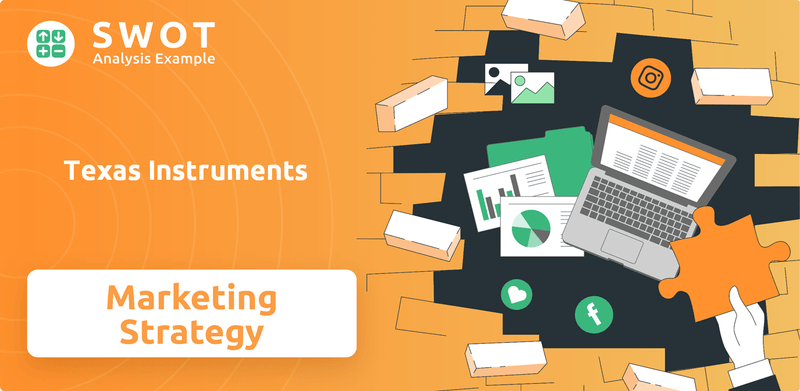
Discover the evolution of Texas Instruments SWOT Analysis, from its early reliance on distributors to its current direct customer engagement model. We'll dissect their sales channels, marketing tactics, and brand positioning, providing insights into how TI stays ahead in the competitive semiconductor landscape. Learn from a company that not only survived a revenue decline but is also poised for a significant recovery in 2025, driven by its robust TI sales and marketing strategies.
How Does Texas Instruments Reach Its Customers?
The sales and marketing strategy of Texas Instruments (TI) centers on a multifaceted approach, utilizing a blend of direct and indirect channels to reach its extensive customer base. This strategy is crucial for a semiconductor company marketing its products effectively. TI's focus is on maintaining a strong presence in the market while adapting to evolving customer preferences and technological advancements.
TI's sales strategy is designed to cater to a diverse range of customers across various technology sectors. The company has strategically shifted towards direct sales, enhancing its control over customer interactions and supply chain dynamics. This approach allows for more personalized service and a more reliable supply of products.
The company's sales channels are a critical component of its overall strategy. TI has streamlined its distribution network to optimize efficiency and customer engagement. This involves a combination of direct sales through its website and internal teams, along with strategic partnerships with authorized distributors.
TI prioritizes direct sales through its official website, TI.com, and an extensive internal sales and marketing team. These channels allow for direct customer engagement and provide control over the sales process. In 2024, direct sales accounted for approximately 80% of TI's revenue, a significant increase from about one-third in 2019.
TI leverages authorized online resellers and electronic component marketplaces as e-commerce platforms. These platforms expand the reach of TI products to a wider audience. This approach supports TI product promotion and provides customers with convenient purchasing options.
TI maintains key partnerships with authorized distributors like Arrow (globally, excluding Japan), Macnica, and TED (in Japan). These distributors serve customers who prefer purchasing through established channels. These partnerships are essential for integrated circuit sales and market penetration.
TI strategically places distribution centers, including a new one in Europe with 9,000 square meters of space, to ensure fast delivery. The goal is to deliver orders to customers in two days or less. This efficiency is critical for meeting customer demands and maintaining a competitive edge.
TI's sales and marketing strategy is marked by several key initiatives designed to enhance customer engagement and streamline operations. The company's focus on direct sales, coupled with strategic distribution partnerships, reflects a commitment to customer satisfaction and efficient supply chain management. For more insights into TI's overall approach, consider reading about the Growth Strategy of Texas Instruments.
- Direct Customer Relationships: Building closer relationships with customers to provide better service and ensure supply.
- API Integration: Offering APIs to automate the buying experience for customers integrating TI products directly into their procurement systems.
- Distribution Network Optimization: Streamlining the distribution network by terminating agreements with certain distributors to gain first-hand customer information.
- Fast Delivery: Utilizing distribution centers to ensure quick order fulfillment, aiming for delivery within two days.
Texas Instruments SWOT Analysis
- Complete SWOT Breakdown
- Fully Customizable
- Editable in Excel & Word
- Professional Formatting
- Investor-Ready Format
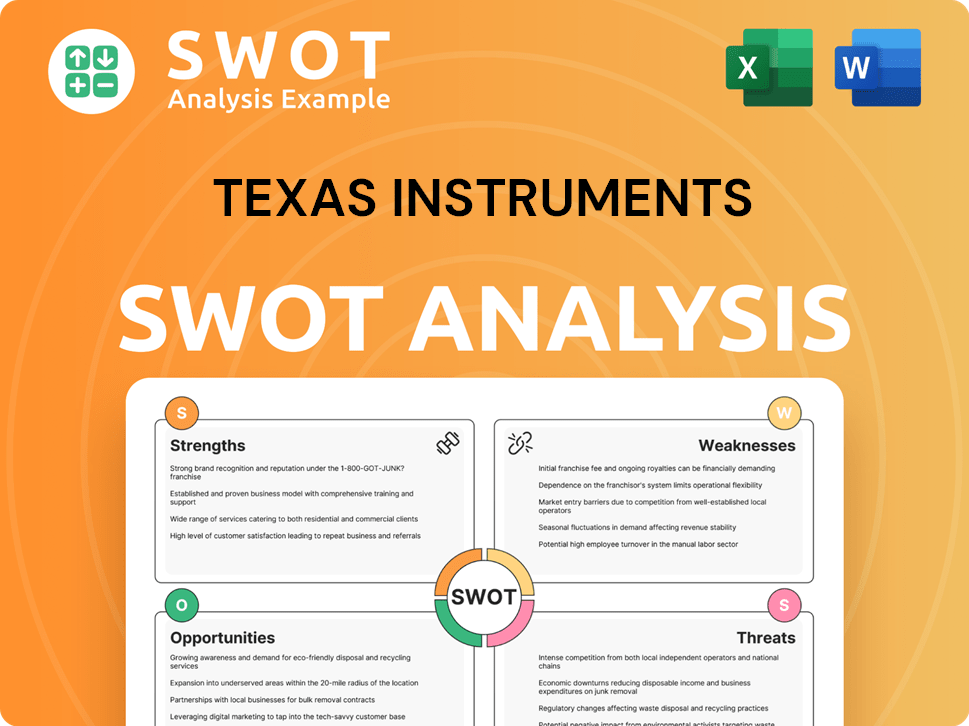
What Marketing Tactics Does Texas Instruments Use?
The marketing tactics employed by Texas Instruments (TI) are multifaceted, blending digital and traditional approaches to boost awareness, generate leads, and drive sales. Their primary focus is on a business-to-business (B2B) marketing strategy. This strategy emphasizes data-driven marketing, customer segmentation, and personalization to enhance customer experiences and drive business growth.
Digital marketing plays a crucial role in TI's strategy. They utilize content marketing, SEO, paid advertising, email marketing, and social media platforms. TI also actively promotes new product launches and publishes numerous blogs to engage their target audience, which includes organizations, students, and technology enthusiasts. Their approach is designed to track purchase intent and escalate engagement.
TI's marketing mix has evolved, with a notable shift towards direct customer relationships and leveraging e-commerce capabilities on TI.com. This provides real-time inventory views and self-service tools for order management. They also participate in trade shows and industry events globally to showcase products and network with potential customers. This comprehensive strategy aims to build strong customer relationships and drive sales in the competitive semiconductor market.
Digital marketing is a cornerstone of TI's strategy, encompassing content marketing, SEO, and paid advertising. They actively use email marketing and social media platforms like YouTube, Twitter, and Facebook. This approach ensures broad reach and targeted engagement with their audience.
TI publishes a wealth of content, including promotional materials and informative blogs, to engage their target audience. This content strategy supports new product launches and provides valuable information. The goal is to foster deeper engagement with potential customers.
TI leverages data analytics to refine online experiences for customers. They partner with sales and IT teams to create data-driven strategies. This approach is designed to drive business growth and improve customer interaction.
The company uses AI-driven automation and optimization tools, such as Personif.ai, to enhance engagement. This includes focusing on bottom-of-funnel content to track purchase intent. The use of AI significantly boosts engagement metrics.
TI emphasizes direct customer relationships and utilizes e-commerce capabilities on TI.com. This provides real-time inventory views and self-service tools. This approach streamlines the sales process and enhances customer convenience.
TI actively participates in trade shows, conferences, and industry events worldwide. This allows them to showcase products and network with potential customers. These events are crucial for building relationships and generating leads.
TI's marketing tactics are designed to reach a wide audience and drive sales. Their approach is multifaceted, combining digital and traditional methods.
- Digital Marketing: Includes content marketing, SEO, paid advertising, email marketing, and social media.
- Content Strategy: Focuses on new product launches and informative blogs to engage the target audience.
- Data Analytics: Utilizes data to improve online experiences and create data-driven strategies.
- AI Automation: Employs tools like Personif.ai to boost engagement, particularly with bottom-of-funnel content. For example, TI saw a 388% increase in bottom-of-funnel content engagement.
- E-commerce: Leverages TI.com for direct sales, providing real-time inventory views and self-service tools.
- Events and Trade Shows: Participates in global events to showcase products and network with customers.
Texas Instruments PESTLE Analysis
- Covers All 6 PESTLE Categories
- No Research Needed – Save Hours of Work
- Built by Experts, Trusted by Consultants
- Instant Download, Ready to Use
- 100% Editable, Fully Customizable
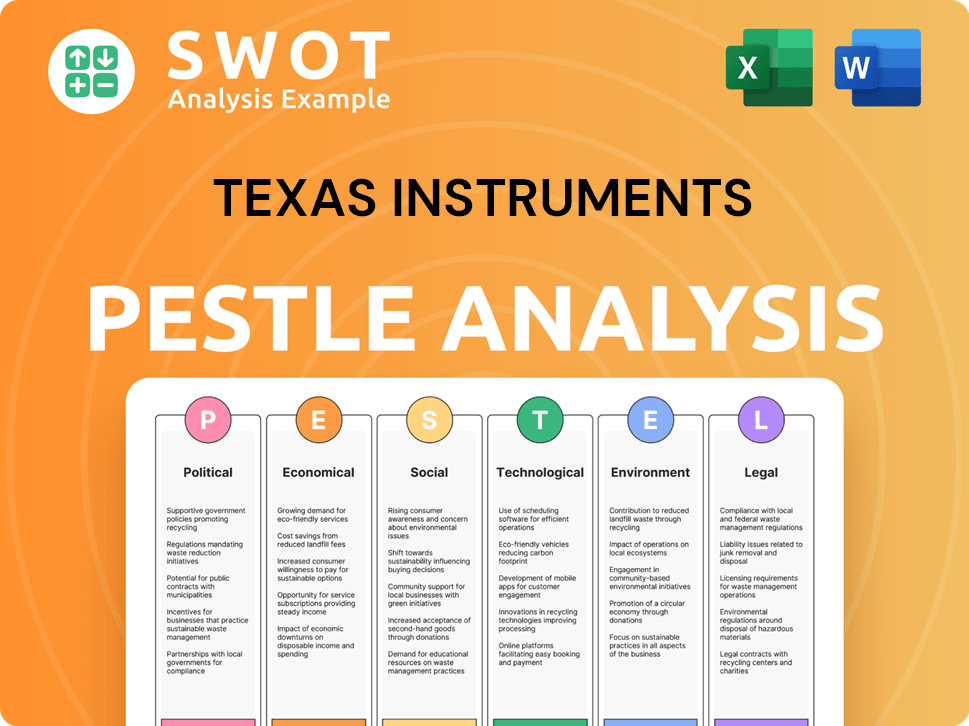
How Is Texas Instruments Positioned in the Market?
Texas Instruments (TI) strategically positions its brand as a global leader in innovative semiconductor solutions. This is achieved through technological excellence, a broad product portfolio, and a strong commitment to customer relationships and sustainability. The core message revolves around 'making electronics more affordable through semiconductors,' emphasizing innovation, efficiency, reliability, and affordability in its products.
The company focuses on analog and embedded processing chips, which constitute over 90% of its revenue, solidifying its market position. TI's visual identity and tone of voice are professional and technologically forward, appealing to its target audience of engineering and technology professionals. This approach ensures that the brand resonates with its core customers, including those in specialized industries.
TI's customer experience promises reliability and quality, fostering strong customer relationships that contribute to a loyal customer base. The company maintains brand consistency across various channels and touchpoints, from its direct sales portal (TI.com) to authorized resellers and industry events. TI also responds to shifts in consumer sentiment and competitive threats by continuously investing in research and development (R&D) to stay ahead of emerging trends and deliver industry-leading solutions. For more insights into the company's targeted customer groups, explore the Target Market of Texas Instruments.
TI's sales strategy focuses on direct sales through its website and a global network of authorized distributors. This approach allows for direct engagement with customers and efficient distribution of its products. The company emphasizes building relationships with key accounts and providing technical support to ensure customer satisfaction.
The marketing strategy of TI involves a mix of digital marketing, content marketing, and participation in industry events. TI utilizes its website, social media, and online advertising to promote its products and solutions. They also create technical documentation, application notes, and design resources to support engineers and designers.
TI promotes its products through detailed datasheets, sample requests, and online design tools. They regularly introduce new products and technologies to maintain a competitive edge. The company also invests in providing extensive technical support and training to assist customers in using their products effectively.
A key aspect of TI's success is its ability to adapt to market changes and customer needs. For example, in 2023, TI invested approximately $1.9 billion in R&D to develop new products. This continuous investment in innovation and customer support is a cornerstone of their sales and marketing strategy.
Texas Instruments Business Model Canvas
- Complete 9-Block Business Model Canvas
- Effortlessly Communicate Your Business Strategy
- Investor-Ready BMC Format
- 100% Editable and Customizable
- Clear and Structured Layout
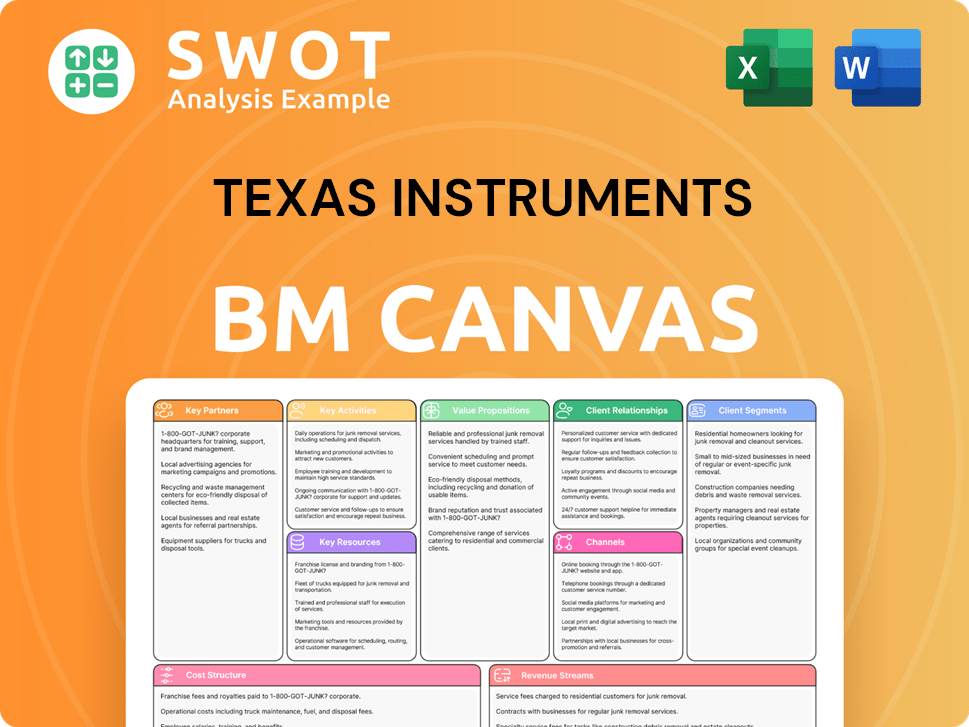
What Are Texas Instruments’s Most Notable Campaigns?
Texas Instruments' (TI) sales and marketing strategy centers around integrated campaigns designed to boost brand presence and drive product sales within the B2B semiconductor sector. These initiatives are carefully targeted, often focusing on specific objectives like amplifying brand visibility and engaging with the engineering community. The company frequently collaborates with partners to execute these multifaceted digital campaigns.
A key element of TI’s marketing strategy is highlighting the practical benefits of its technology in solving real-world challenges. This approach involves showcasing how TI’s products provide specific value propositions to organizations. While specific financial metrics for individual campaigns aren't always publicly detailed, the overarching strategy emphasizes innovation and substantial investments in research and development, which underpins all their marketing efforts.
TI’s marketing efforts are a key part of their overall strategy. They focus on specific objectives within the B2B semiconductor landscape. TI uses integrated campaigns to achieve these goals, focusing on brand amplification and community engagement.
TI utilizes platform-specific social media campaigns to increase engagement. These campaigns often coincide with product launches. The goal is to generate buzz and drive sales of tools and other products.
Viral marketing is a key component of TI's strategy, particularly during product releases. These strategies aim to create a buzz and increase toolkit sales. This helps drive traffic to product pages.
TI promotes its technology by highlighting how it solves real-world problems. For instance, they showcased innovations that detect water or gas leaks. This B2B marketing technique demonstrates the specific value of TI's products.
TI engages in partnerships to expand its reach in specific markets. Their recent collaboration with Derivita, announced on June 4, 2025, integrates math support with TI graphing calculators. This strengthens their position in the education sector.
The results of these integrated PR and digital strategies have been significant. For example, there was a reported 2100% increase in Facebook likes and a 400% boost in Twitter followers. These campaigns have successfully driven traffic to product pages, tool sales, and Engineer-to-Engineer (E2E) participation. To learn more about how TI approaches these strategies, consider reading this insightful article on Texas Instruments sales and marketing.
Texas Instruments Porter's Five Forces Analysis
- Covers All 5 Competitive Forces in Detail
- Structured for Consultants, Students, and Founders
- 100% Editable in Microsoft Word & Excel
- Instant Digital Download – Use Immediately
- Compatible with Mac & PC – Fully Unlocked
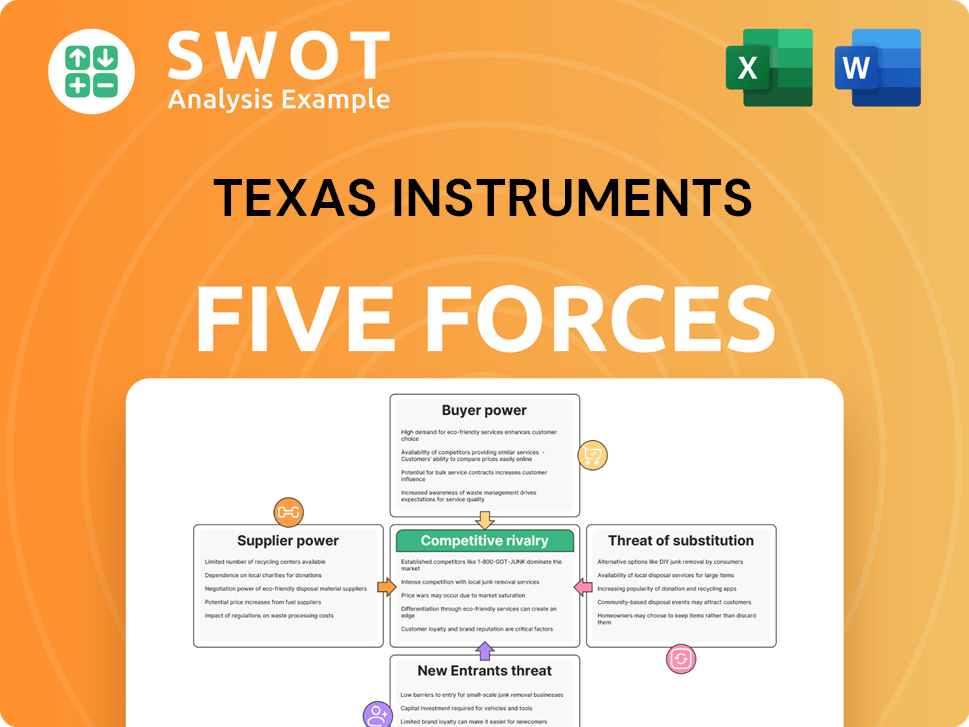
Related Blogs
- What are Mission Vision & Core Values of Texas Instruments Company?
- What is Competitive Landscape of Texas Instruments Company?
- What is Growth Strategy and Future Prospects of Texas Instruments Company?
- How Does Texas Instruments Company Work?
- What is Brief History of Texas Instruments Company?
- Who Owns Texas Instruments Company?
- What is Customer Demographics and Target Market of Texas Instruments Company?
Disclaimer
All information, articles, and product details provided on this website are for general informational and educational purposes only. We do not claim any ownership over, nor do we intend to infringe upon, any trademarks, copyrights, logos, brand names, or other intellectual property mentioned or depicted on this site. Such intellectual property remains the property of its respective owners, and any references here are made solely for identification or informational purposes, without implying any affiliation, endorsement, or partnership.
We make no representations or warranties, express or implied, regarding the accuracy, completeness, or suitability of any content or products presented. Nothing on this website should be construed as legal, tax, investment, financial, medical, or other professional advice. In addition, no part of this site—including articles or product references—constitutes a solicitation, recommendation, endorsement, advertisement, or offer to buy or sell any securities, franchises, or other financial instruments, particularly in jurisdictions where such activity would be unlawful.
All content is of a general nature and may not address the specific circumstances of any individual or entity. It is not a substitute for professional advice or services. Any actions you take based on the information provided here are strictly at your own risk. You accept full responsibility for any decisions or outcomes arising from your use of this website and agree to release us from any liability in connection with your use of, or reliance upon, the content or products found herein.